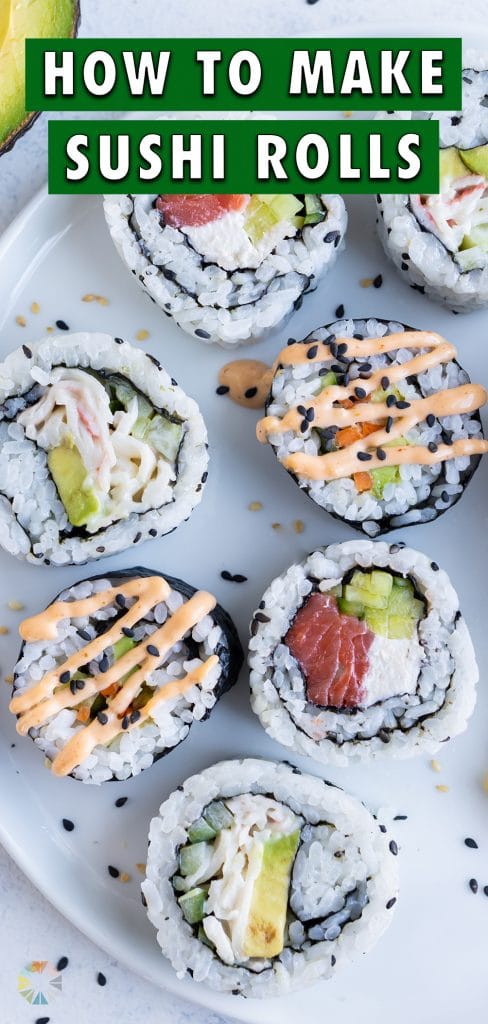By learning How to Roll Sushi at home, you can enjoy incredibly fresh sushi anytime, that turns out so much better than store-bought! Using short-grain sushi rice, nori seaweed, and your favorite fillings for these easy methods, tackling the art of rolling doesn’t have to be difficult. From California and spicy tuna to the simple cucumber rolls, the endless options for this healthy dish will be sure to impress.
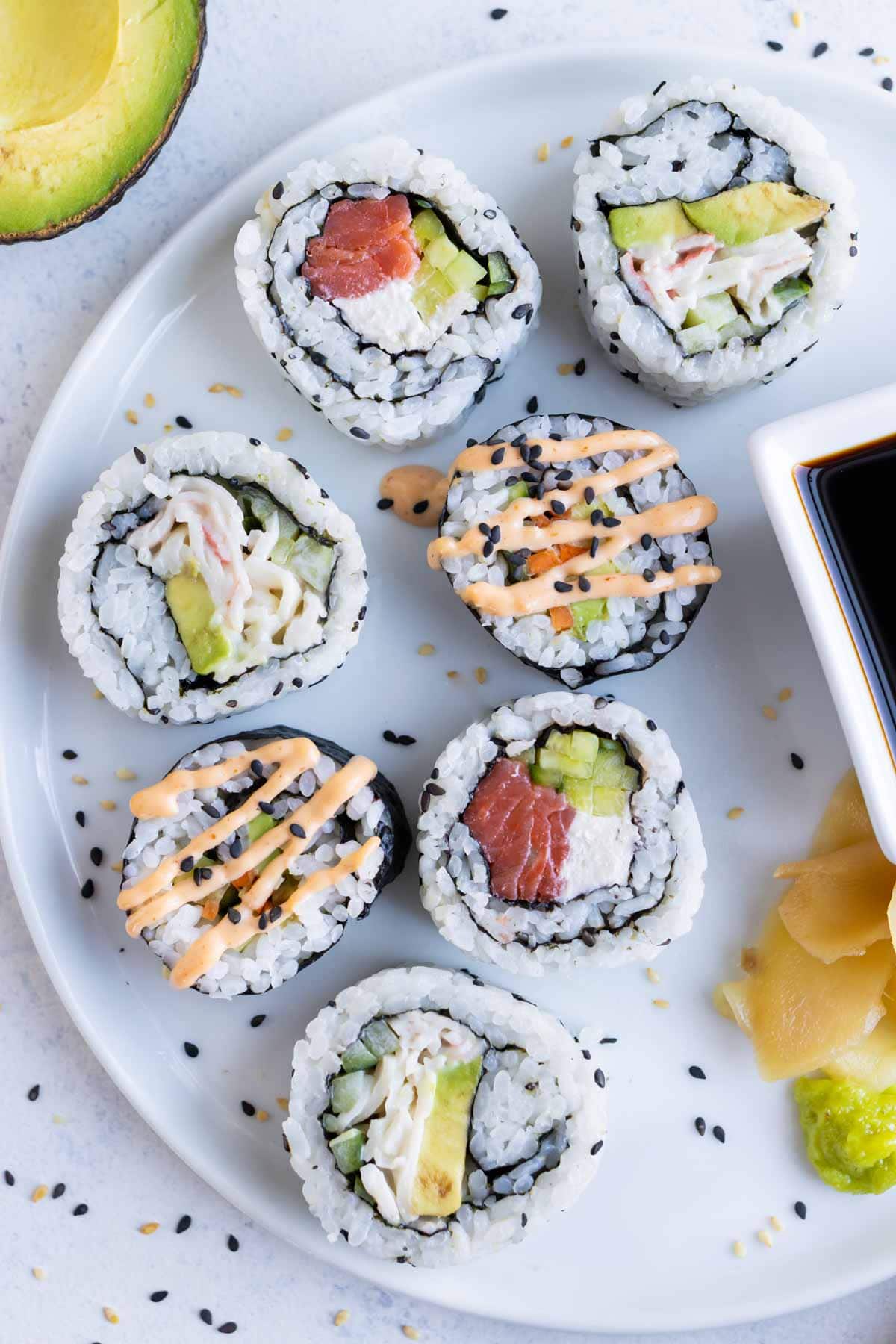
My weekly obsession with buying grocery store sushi finally has to come to an end.
Fresh California Roll, vegetarian Avocado Roll, even creamy, delicious Philadelphia Roll… I decided that it was time I learned how to roll sushi myself, so that I could enjoy every one of them anytime those cravings hit!
But if you’ve ever attempted this somewhat overwhelming task at home, you know that it can be a bit tricky.
Not to mention that making a traditional “maki” roll and an inside-out “umaki” roll with the rice on the exterior require entirely different methods!
After rolling dozens and dozens of these guys, I’m going to be sure to show you all of the tips and tricks I’ve learned. That way you can also easily make your own sushi rolls at home using a bamboo mat.
Don’t have a bamboo mat? No problem – I’ll also teach a little trick so you can use what you already have available!
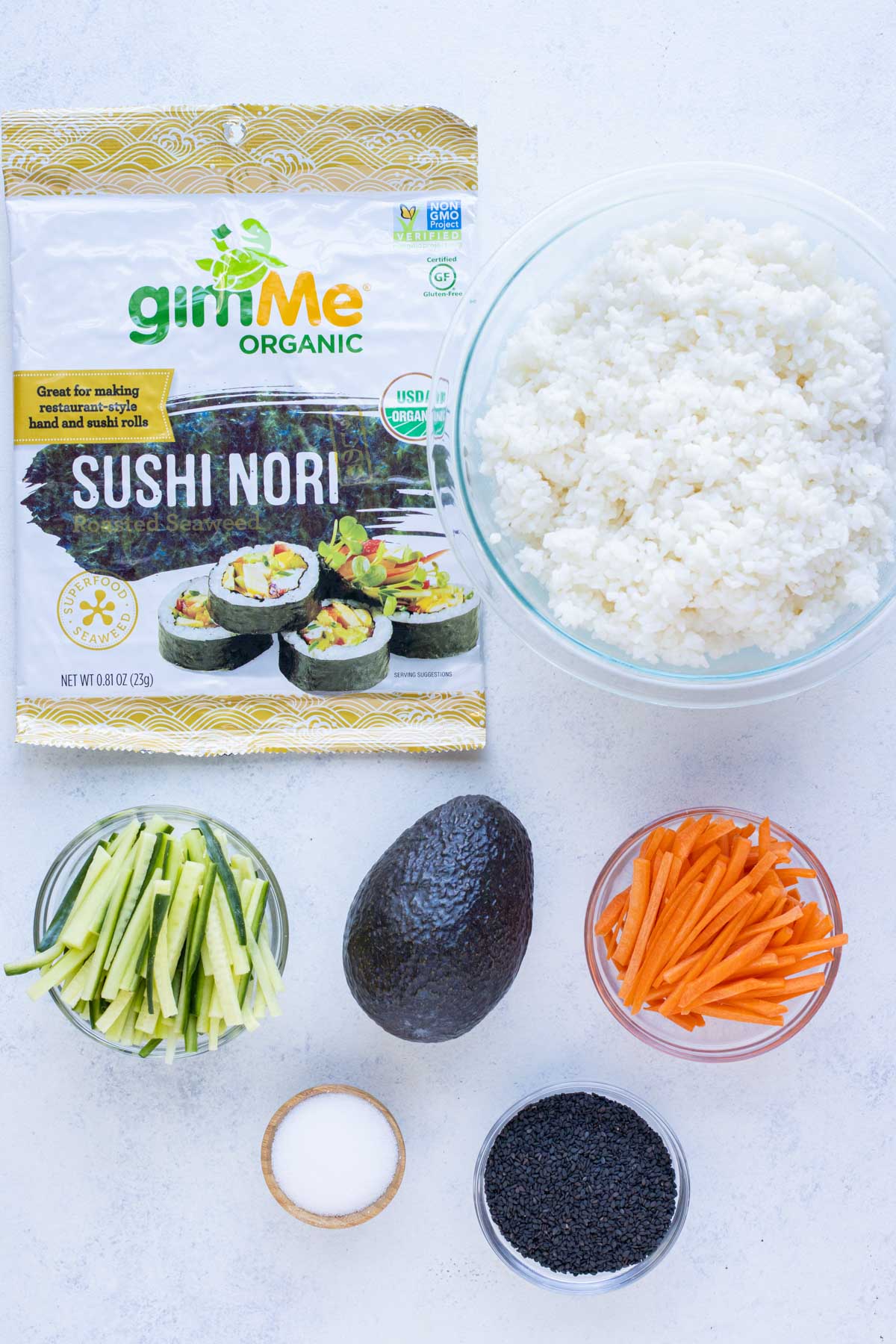
Ingredients
The simple ingredients you need to make this recipe include:
- Sushi Rice. Learning How to Make Sushi Rice is much simpler than you might think, with cooked rice simply being seasoned with rice vinegar and sugar. Short-grain rice is best suited to this recipe, because the slightly sticky nature of it once cooked is perfect for forming sushi.
- Nori. Dried, edible sheets of nori seaweed are a key characteristic of most sushi rolls. Easily found in most Asian markets, it lends a salty, delicately grassy flavor and a binding agent for rolls.
- Fillings. Smoked salmon and cream cheese for Philadelphia Rolls, imitation crab meat for California Rolls, even simple avocado and carrots for Avocado Rolls are just some of the many filling options you can try. Cucumber, spicy tuna, and even shrimp tempura are very popular options as well.
How to Roll Sushi
The basic steps for How to Roll Sushi are simple to follow:
Spread the Rice
Regardless of which type of sushi you plan to make, the first steps for prepping the rice and nori will be nearly the same.
On a bamboo sushi rolling mat, place a sheet of nori with the rough side up, and the lines running in the same direction as the bamboo mat.
As long as it’s handled delicately, the nori can be used straight out of the packaging without needing to be softened at all. The residual moisture from the cooked rice will be more than enough to make it pliable enough for rolling.
Add 1 cup of prepared sushi rice, and gently spread it out as much as you can with a rice paddle. Using a specially designed paddle instead of a spoon or spatula while handling rice makes this step much easier.
To get the rice all the way out to the edges, lightly wet your fingertips in a bowl of water and use them to gently spread the remaining rice.
For traditional maki roll with the nori on the outside, go all of the way out to every edge except for the one furthest from you. Leave a ½-inch edge of nori that will help seal the roll later.
For an inside-out uramaki roll with the rice on the outside, spread the rice all of the way out to every edge.
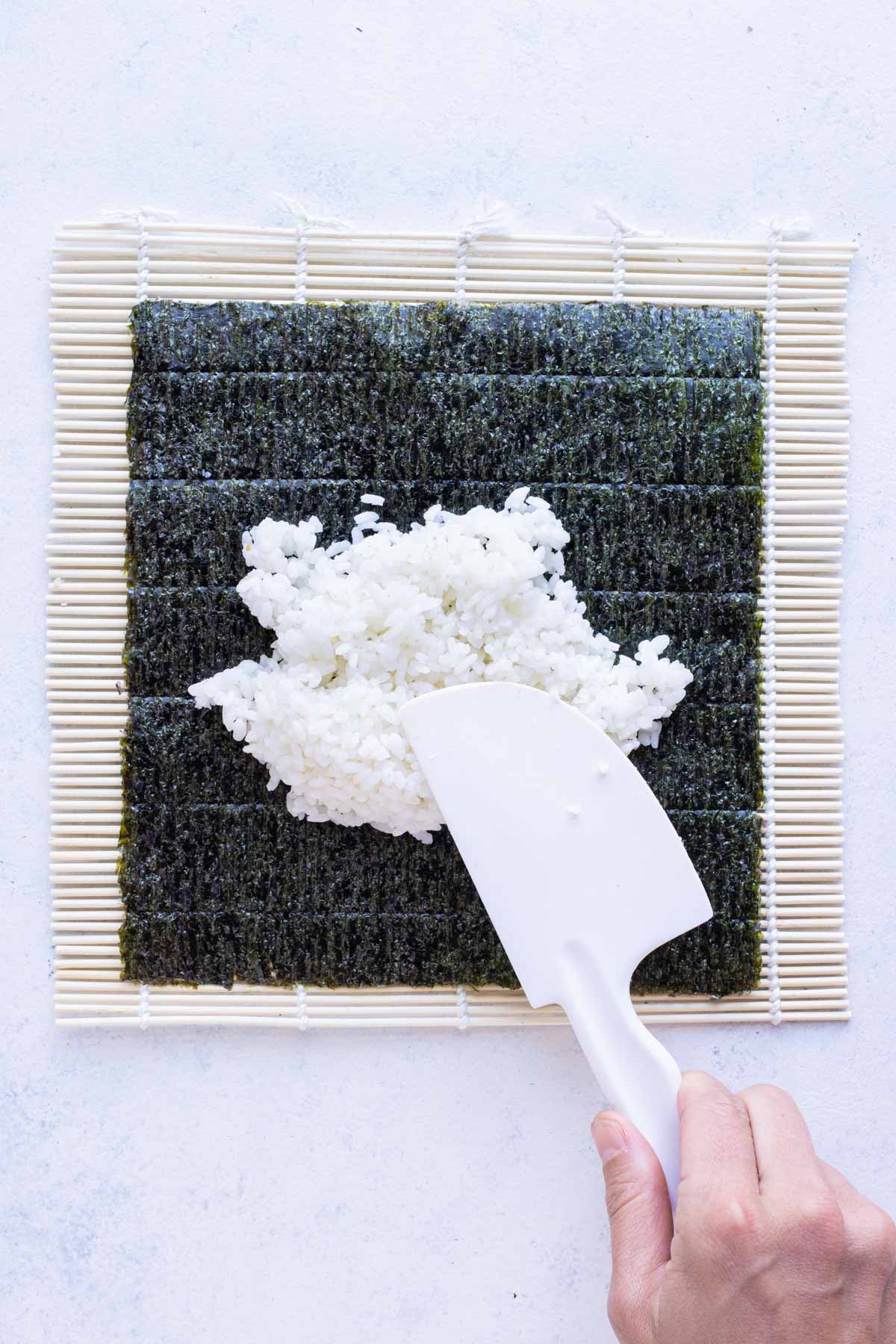
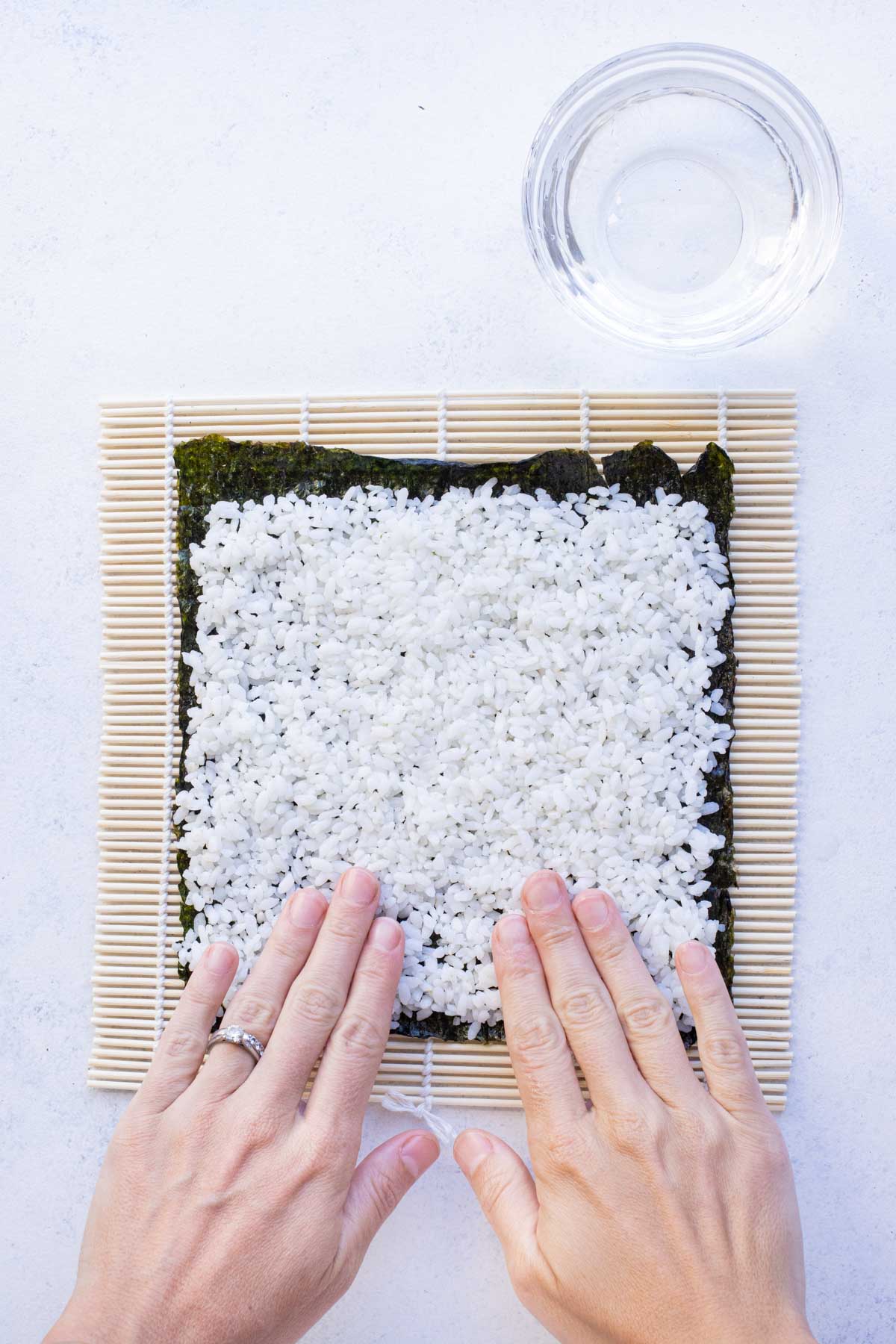
Maki Sushi – Traditional Method
Fill it Up
Prepare all of the ingredients for your intended fillings. You want to ensure everything can be laid out alongside one another in relatively straight “strips,” to create that signature bundle of ingredients in the center.
For options like imitation crab, avocado, shrimp tempura, or other “central” ingredients, a slightly more thick cut may be used. But learning How to Julienne ingredients is particularly helpful for preparing more finely sliced elements like cucumber or carrot.
Slightly off center at the end closest to you, lay out your fillings in relatively even, horizontal rows. Try to keep them close enough to bundle together easily, but straight and separate enough to be distinct in each piece once sliced.
Add a small sprinkling of salt, if desired.
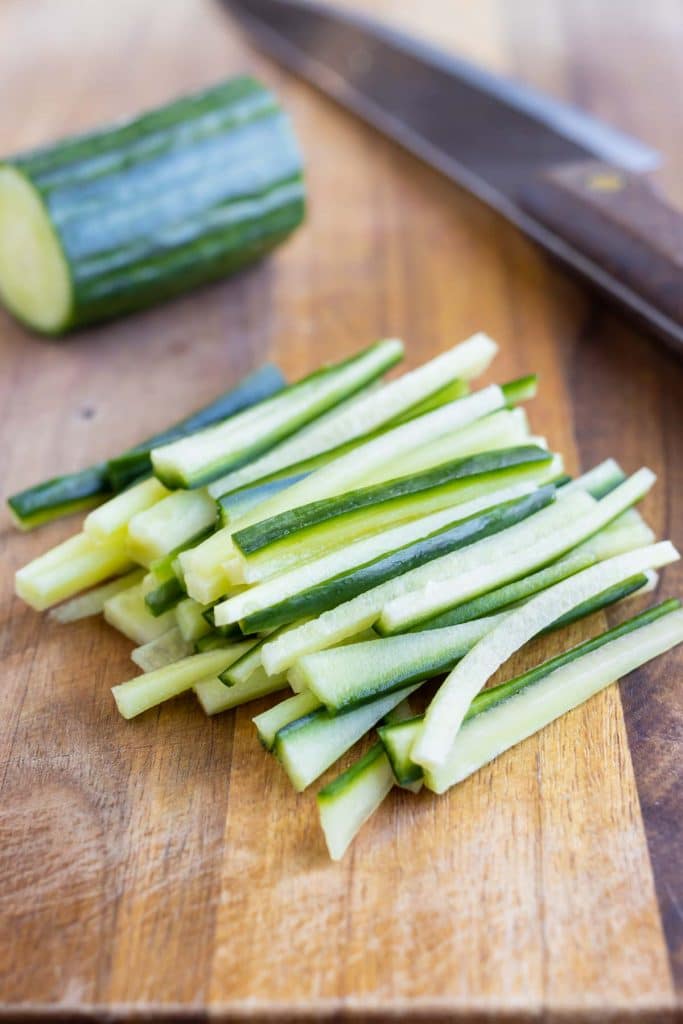
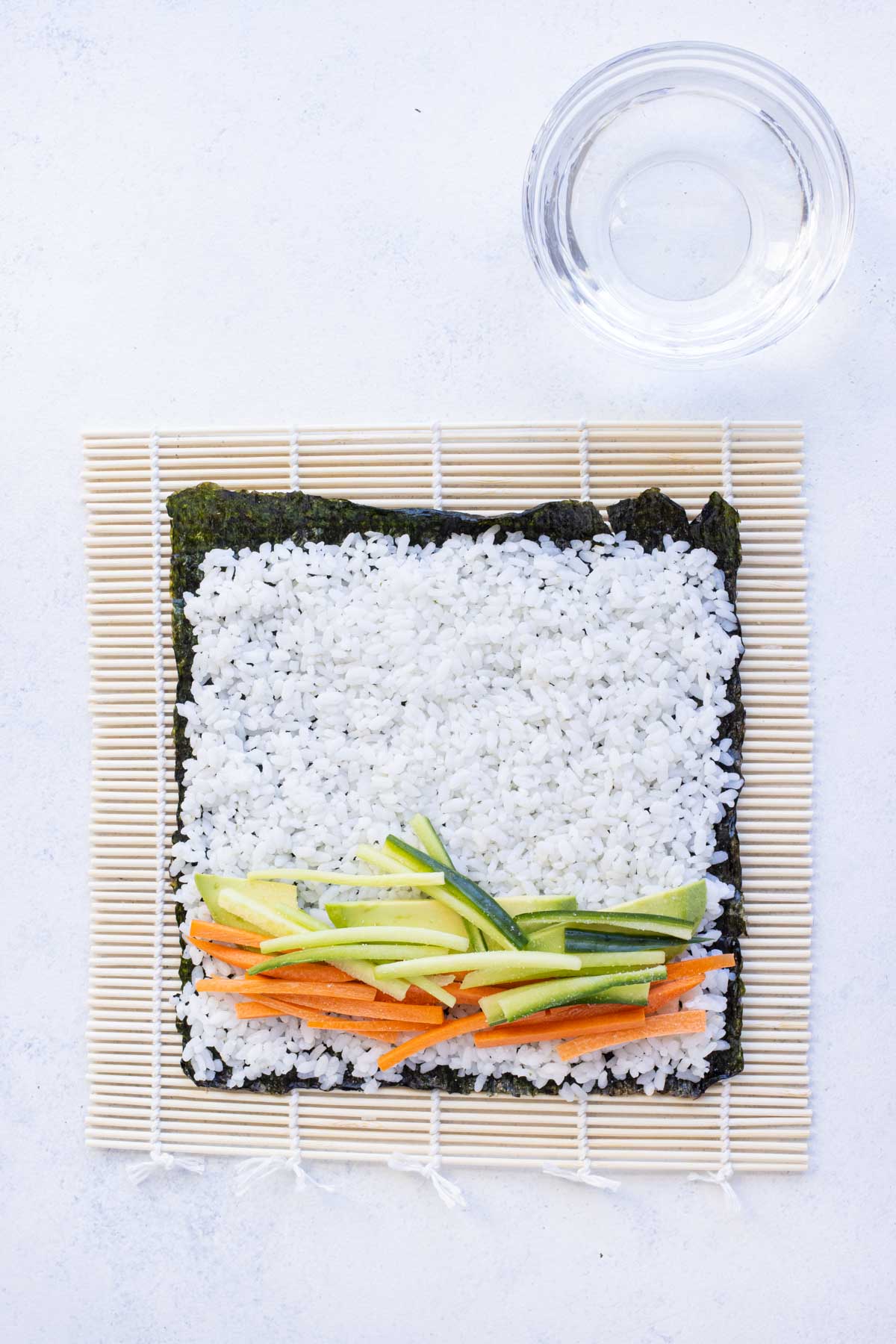
Roll it Tight
Starting at the end closest to you, carefully lift up the edge of the mat to bring the innermost edge of the rice and nori up over the fillings. Begin rolling, using the mat to encourage the roll to take on a circular shape and push the ingredients back in if they begin to shift.
As you go, gently squeeze to tighten the roll up as it forms. This will help compress the rice enough to hold together, which will keep your sushi from falling apart.
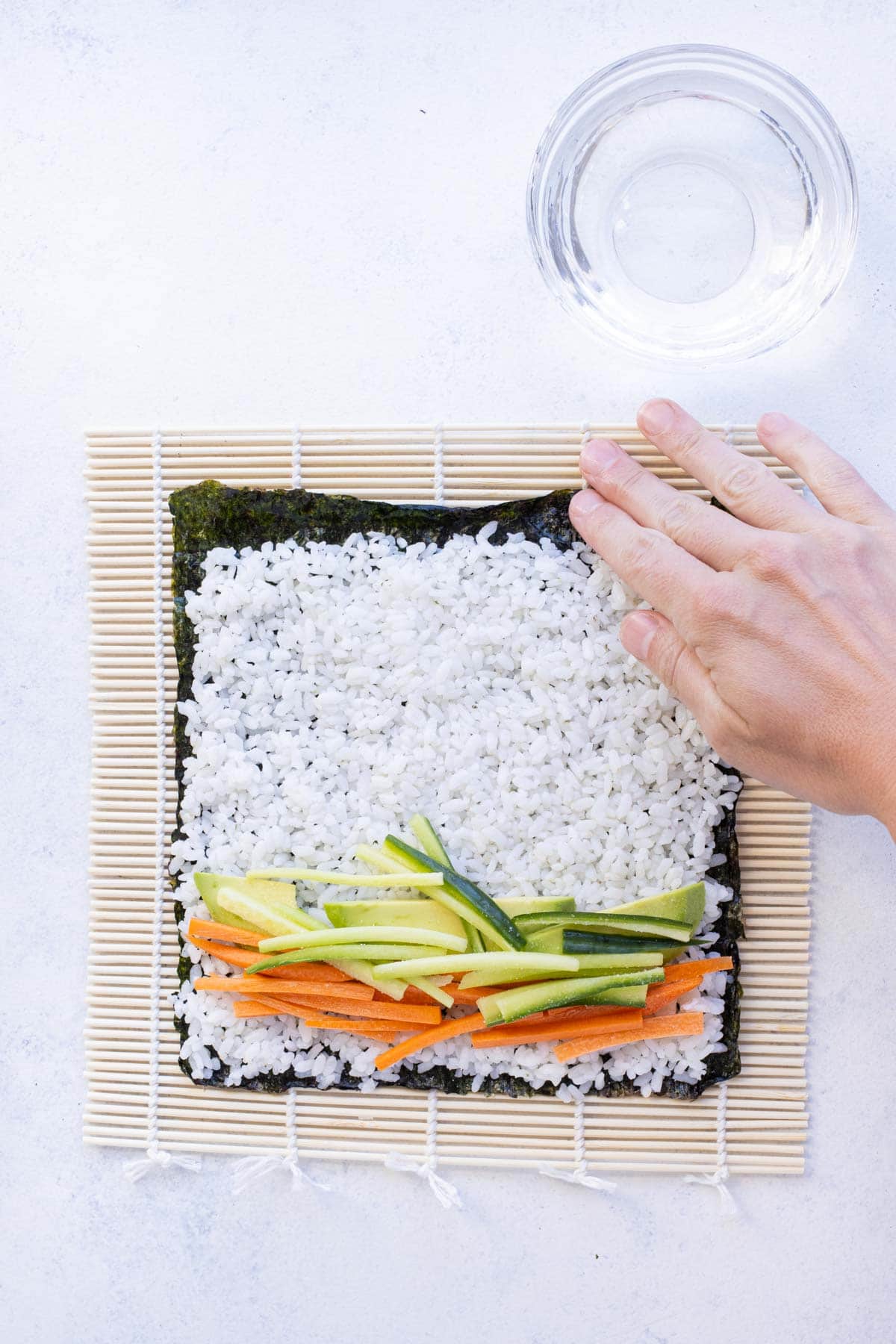
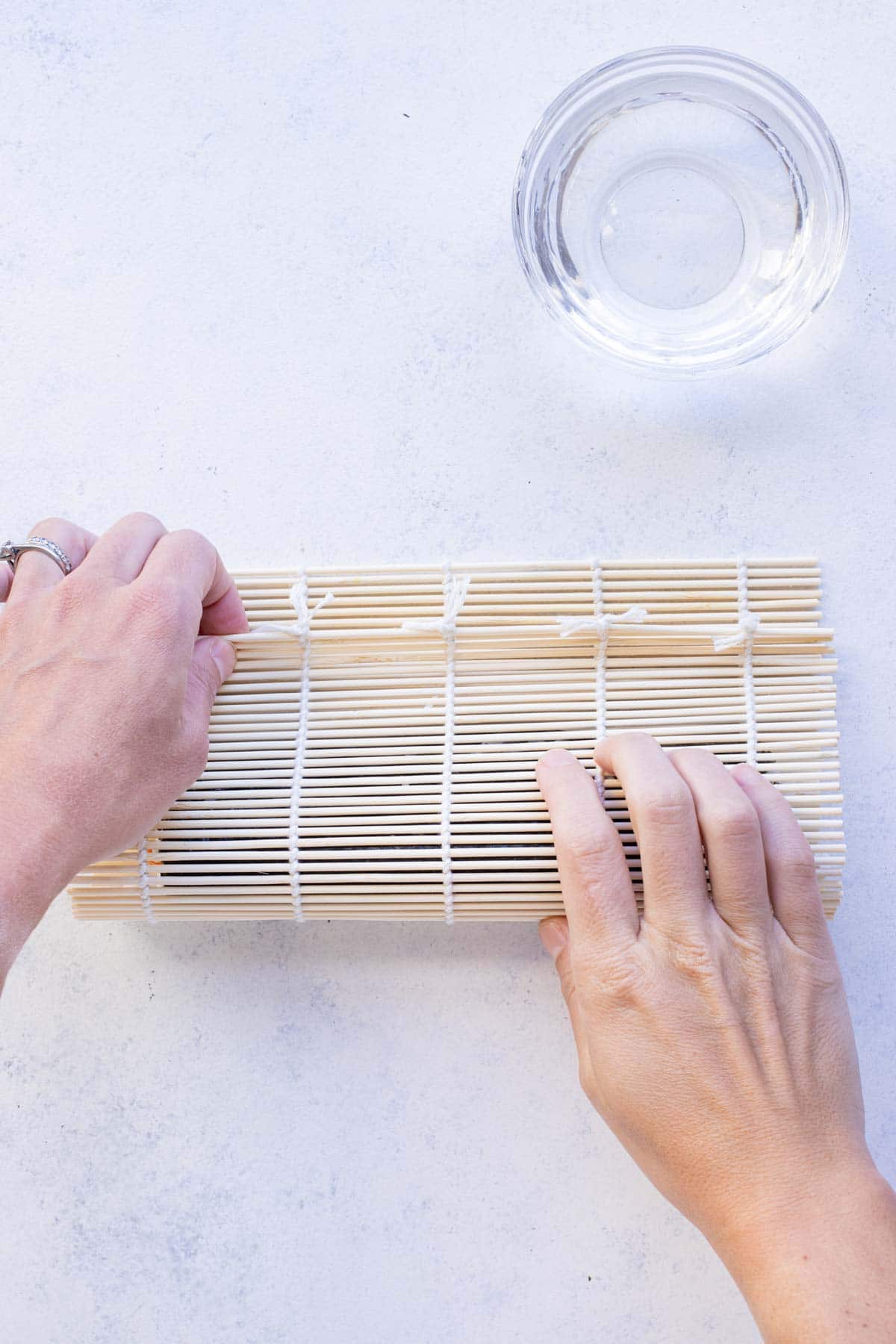
Seal
When the roll is completely formed, gently hold it together with one hand and lightly wet your fingertips of your other hand.
Run them along the ½-inch strip of nori that was left uncovered at the end, softening it and giving it a moist, sticky texture. This will help the edge to stick to the outside of the roll, creating a secure seal.
Gently press the edge up onto the outside of the roll, finishing the spiral of the roll and creating that signature tube shape.
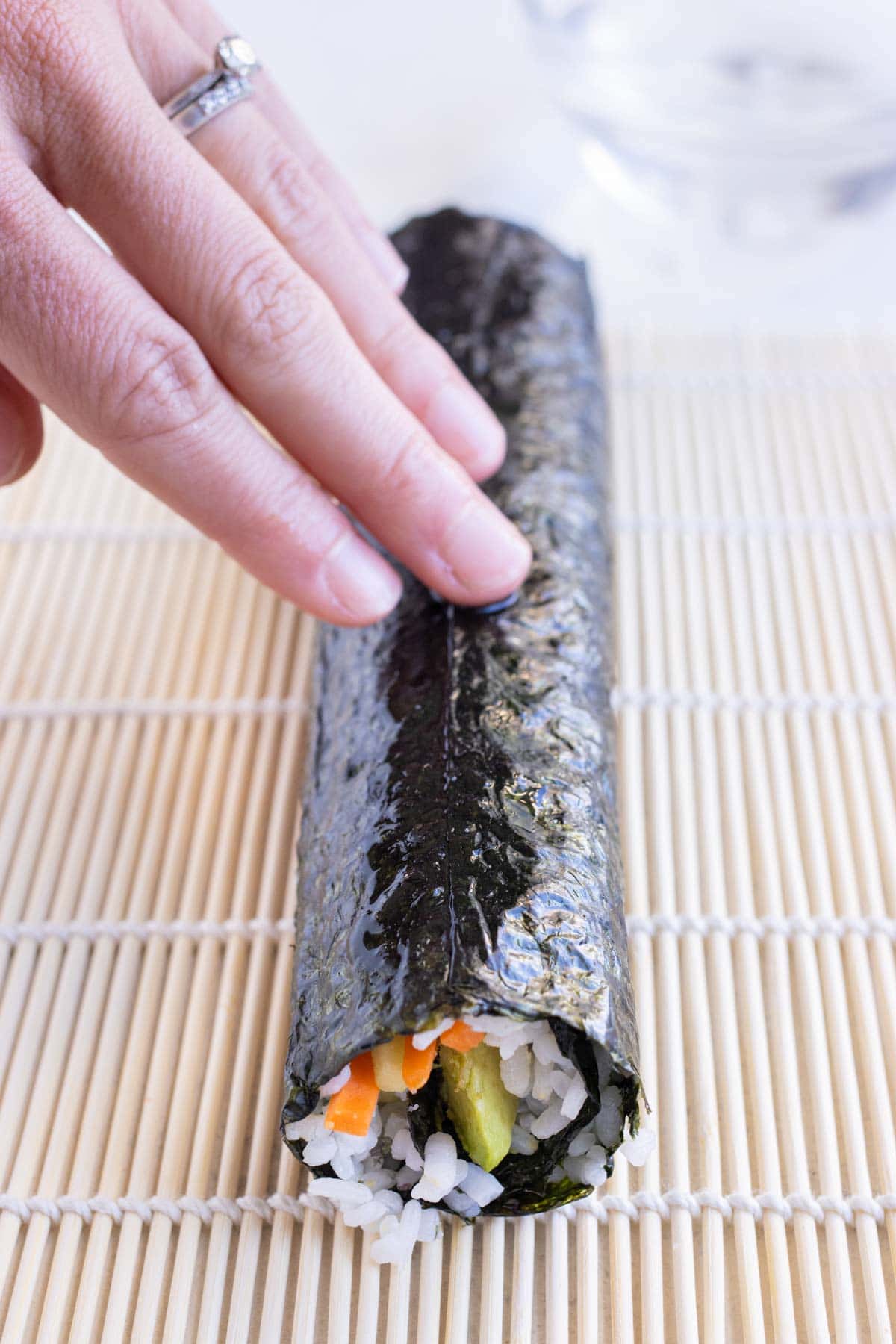
Uramaki Sushi – Inside-Out Method
Sprinkle and Flip
Spread the rice all the way out to the very edges of the nori for this method, as detailed above. If desired, lightly sprinkle some toasted black sesame seeds over the rice, for flavor and decoration.
Lay a sheet of plastic wrap over the rice, and gently flip the nori over on the bamboo mat.
With this method, the plastic acts as a barrier between the mat and the rice to prevent sticking. The blank side of the nori should be facing upward.
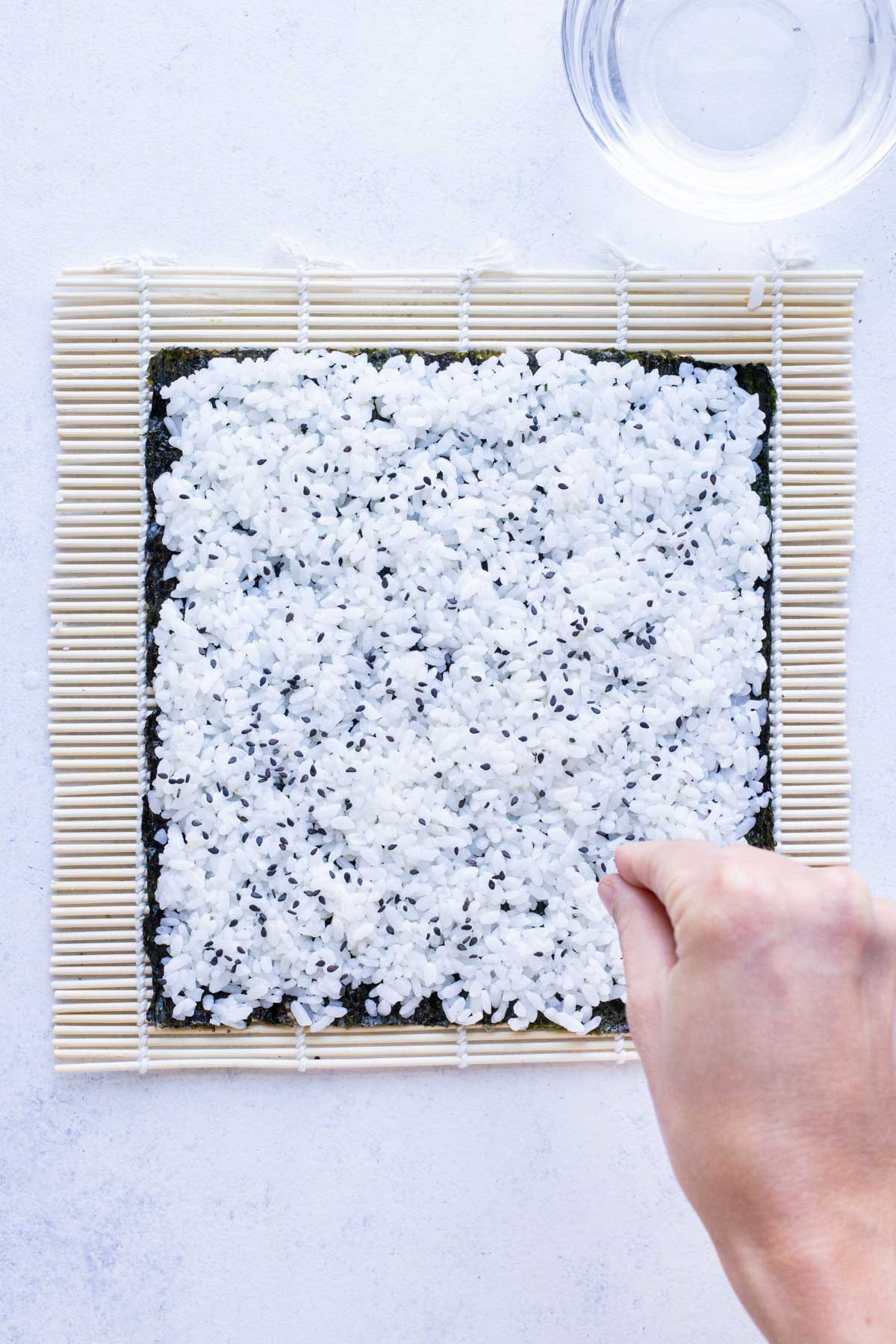
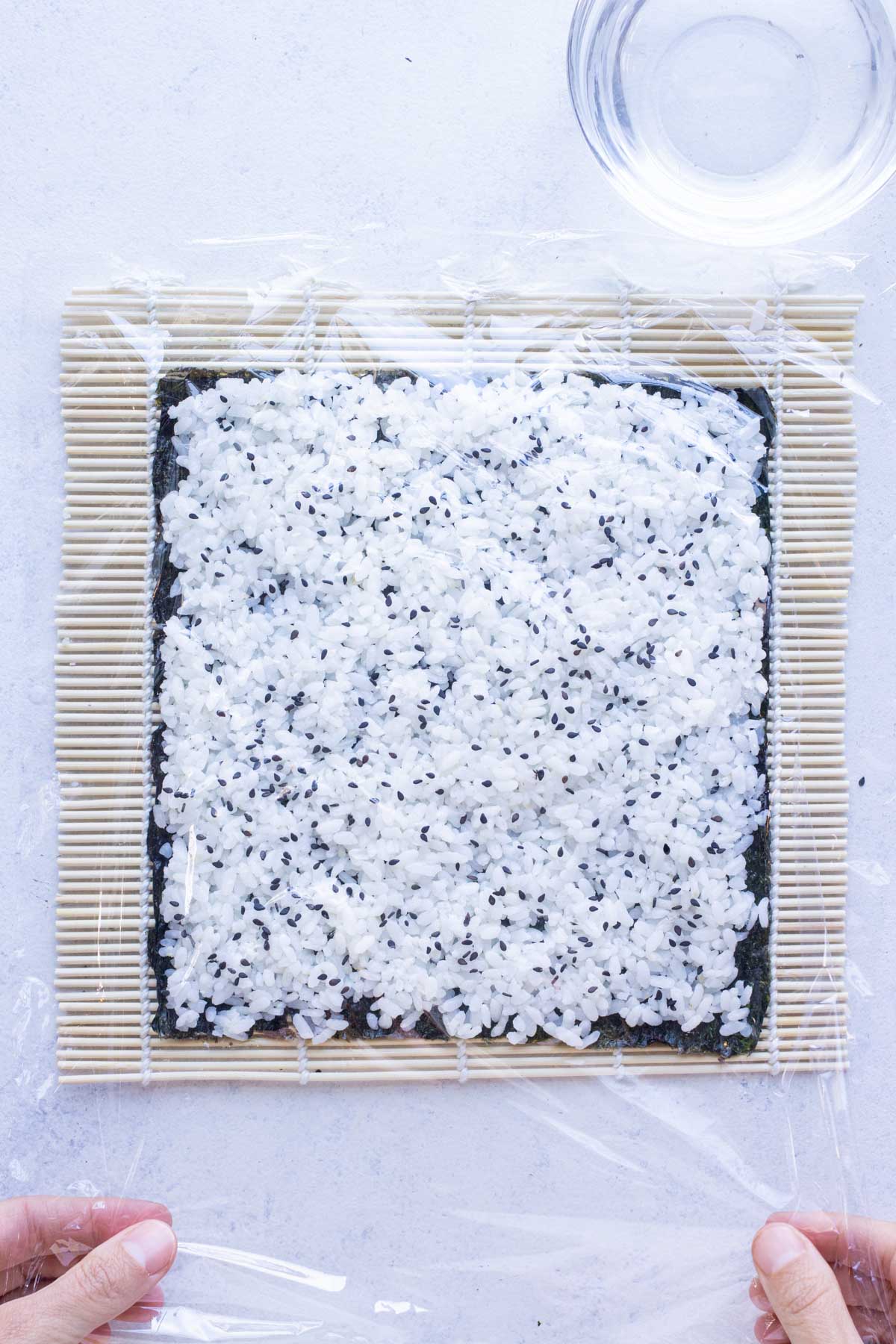
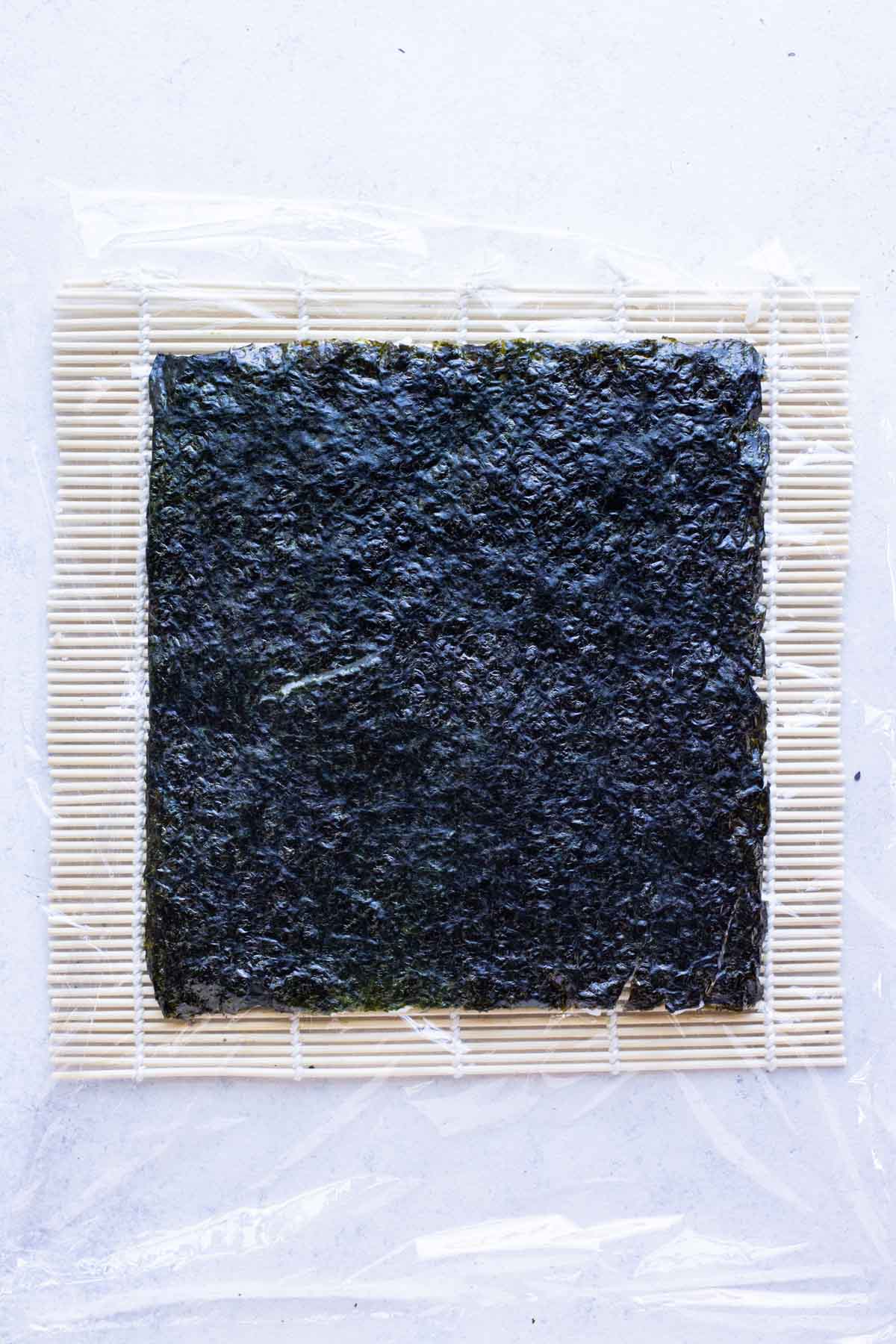
Fill and Roll
Prepare the intended ingredients for your sushi roll. For more central ingredients a thicker cut can be used, but learn How to Julienne ingredients that require longer, thinner strips.
With this method, additional care must be taken in arranging your ingredients, as the lack of rice in the center makes them more prone to shifting around.
Slightly off center at the end toward you, layer the fillings in long, relatively even strips. It’s alright if some excess dangles out either end – this can be trimmed away later.
Add an extra sprinkling of salt to the fillings, if desired, and then begin to roll.
Starting at the edge closest to you, gently life the edge of the mat and roll the rice and nori sheet up over the fillings. Tuck them up inside the innermost edge of the nori, and very gently compress as you go to keep everything stable.
Taking care not to let the bamboo mat OR the plastic wrap get caught up in the roll, continue rolling, shifting filling back into place as needed.
Gently squeeze the roll as it forms, to encourage the rice to take on that iconic circular shape and hold the fillings together.
For this method, sealing isn’t required as the rice sticks together well enough on its own once the roll is formed.
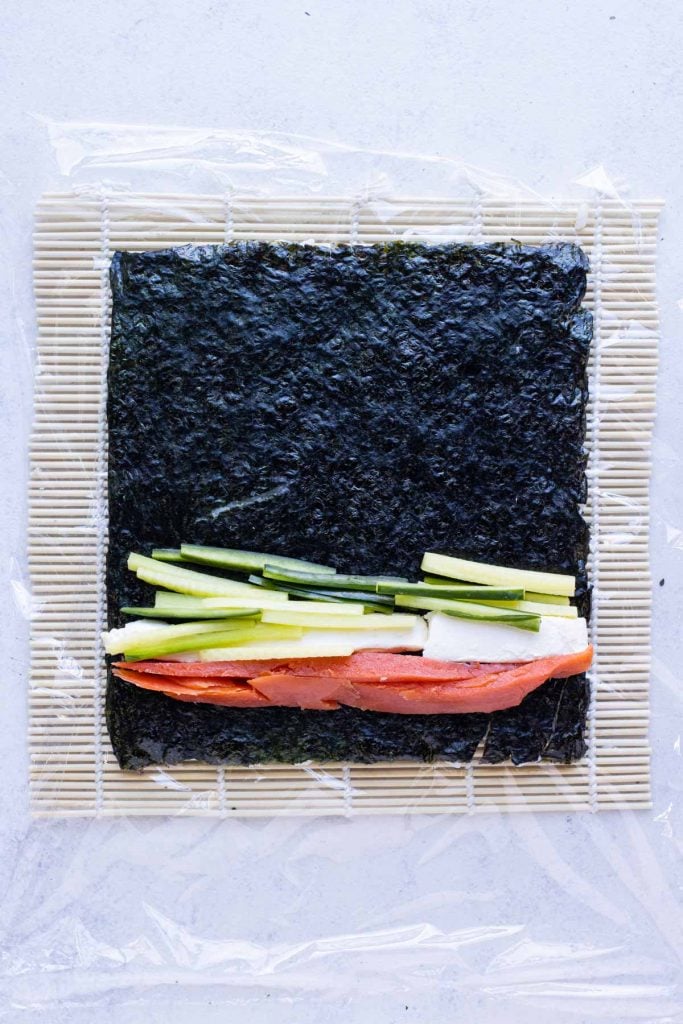
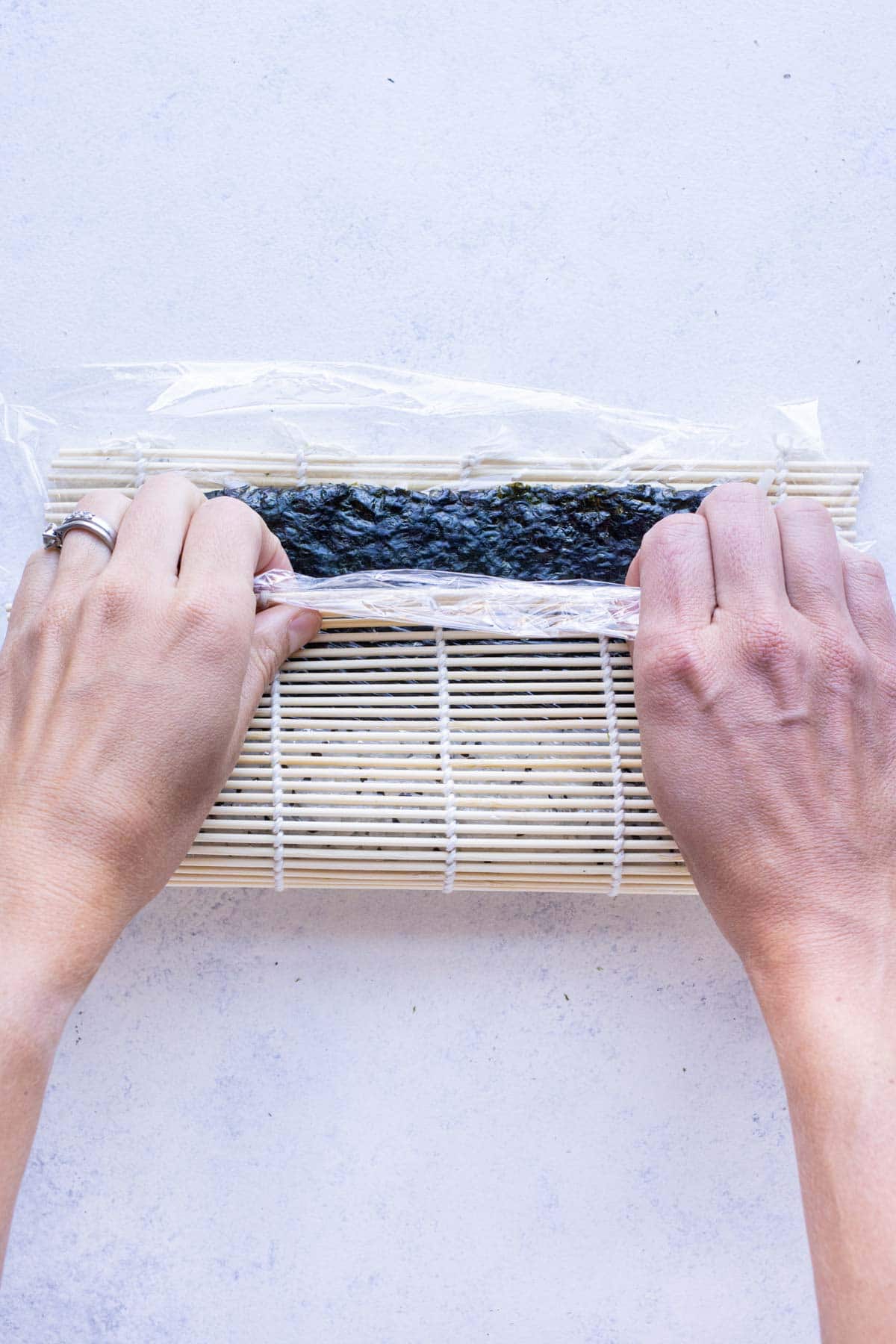

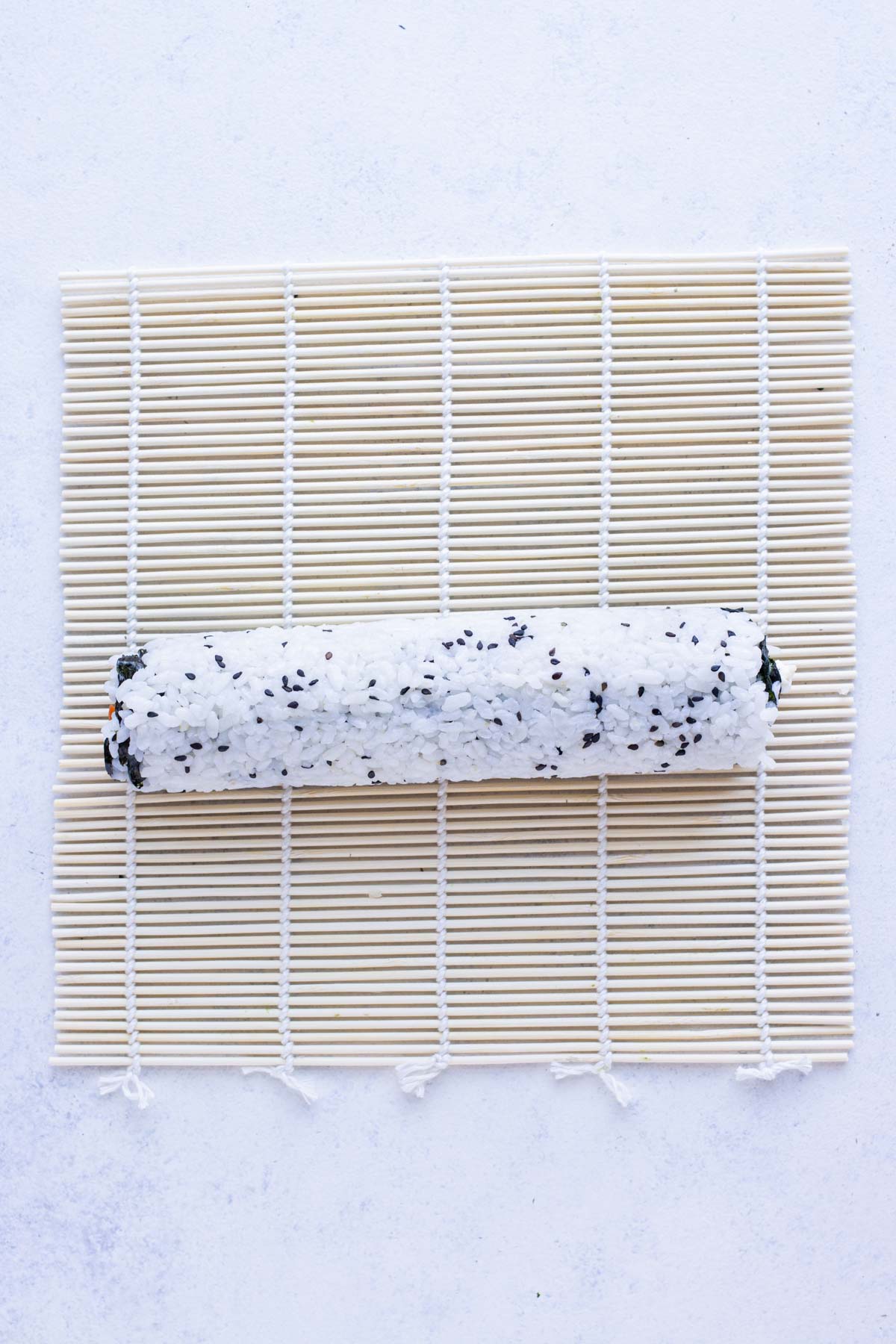
Rolling Sushi Without a Mat
If you don’t have a bamboo mat for rolling sushi, don’t worry! While it’s got slightly less structural support for the roll, using a clean dish cloth or tea towel works too.
Lay the nori and plastic-lined rice out across the tea towel in the same way. Simply roll a little more slowly and carefully, to ensure that the roll takes on the correct shape and level of compression.
How to Cut Sushi Rolls
Lightly wet a very sharp knife, and begin slicing the sushi into even pieces. Use your best judgement on size, but aim for pieces sliced roughly as thick as one finger.
Every 2-3 slices, clean off the knife and wet it anew – this helps to keep each slice neat, and prevents the rice sticking.

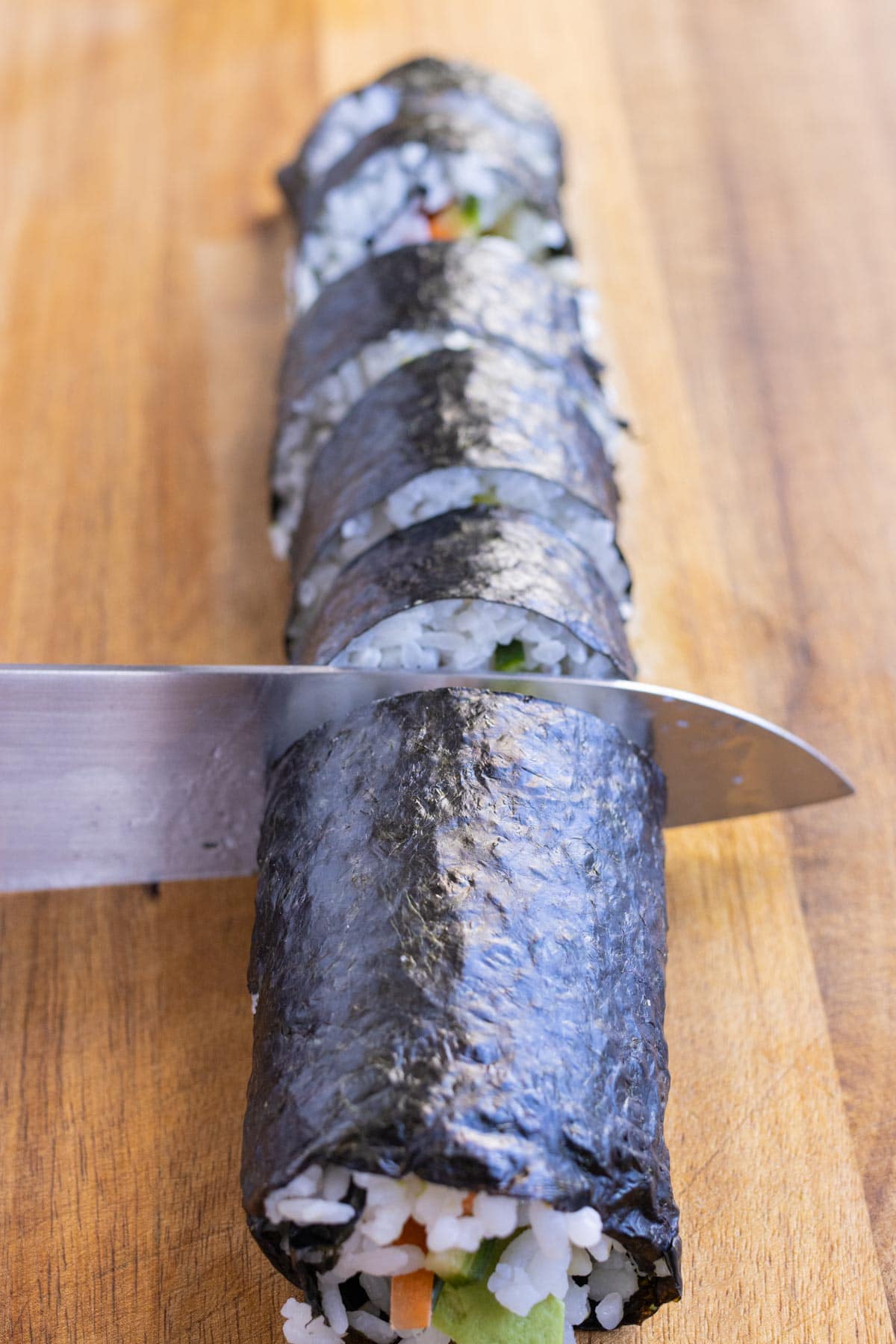
After making an uramaki roll, it’s much easier to remove any remaining plastic wrap AFTER the sushi has been sliced. This helps to hold it together, and avoid the mess of rice clinging to your fingers as you cut it!
Arrange your sushi on a platter, and enjoy!
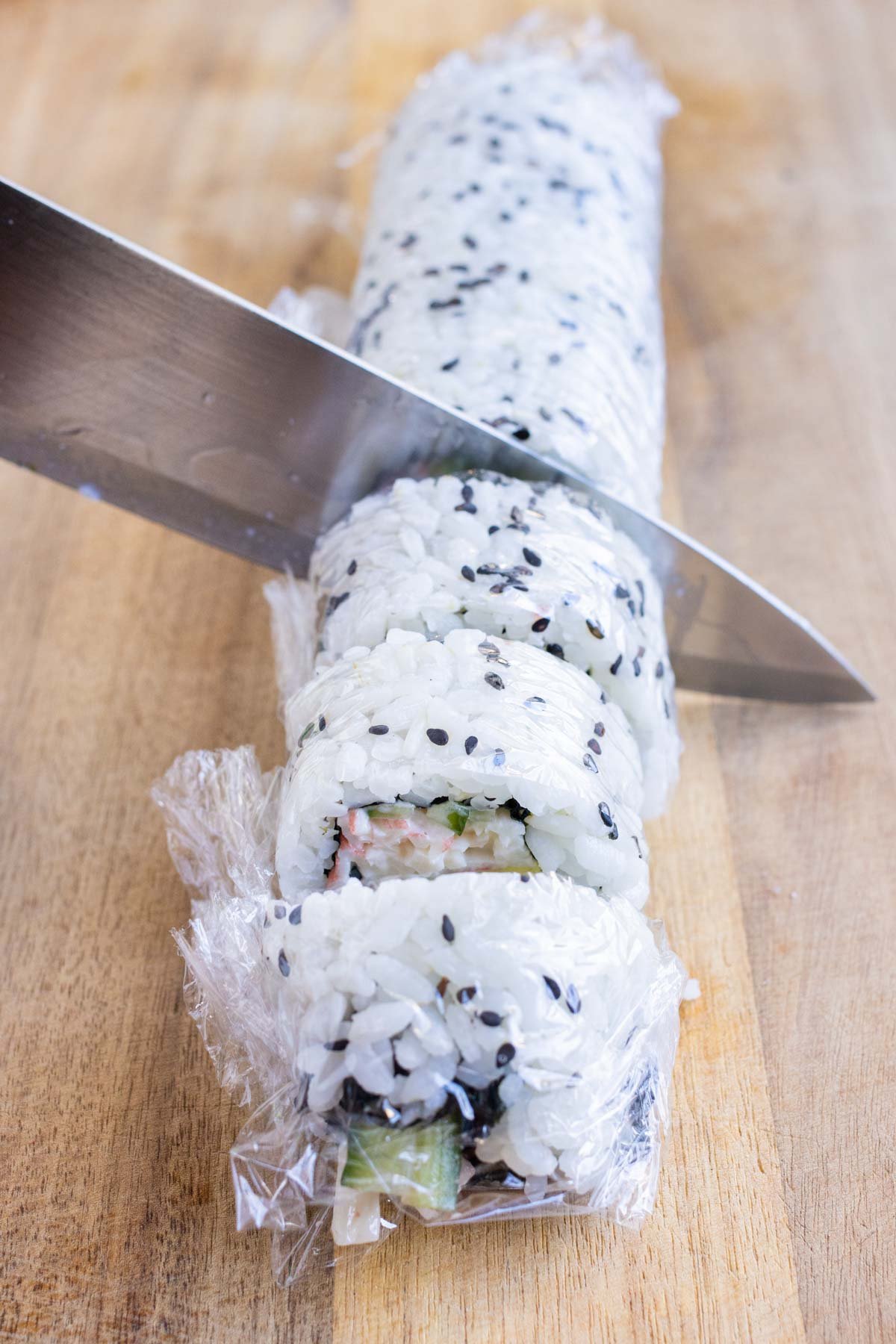
Sauces to Serve with Sushi
Sushi can be served with a wide variety of accompaniments for dipping. Soy sauce, wasabi, thick and sweet eel sauce, fish roe, sriracha mayo, and citrus-based ponzu sauce are very popular options to consider.
Pickled ginger is also commonly served alongside sushi, to act as a palate cleanser between bites.
Meal Prep and Storage
- To Prep-Ahead: Sushi is best if eaten within the first few hours of making. But it can prepared up to 24 hours ahead of time if kept tightly wrapped in plastic wrap inside the refrigerator.
- To Store: Ideally, slice sushi as it is intended to be eaten and leave leftovers uncut. Wrap rolls or pieces together in plastic wrap for up to two days. After that, the rice will go hard and the vegetables will brown.
- To Freeze: It is not recommended to freeze sushi.
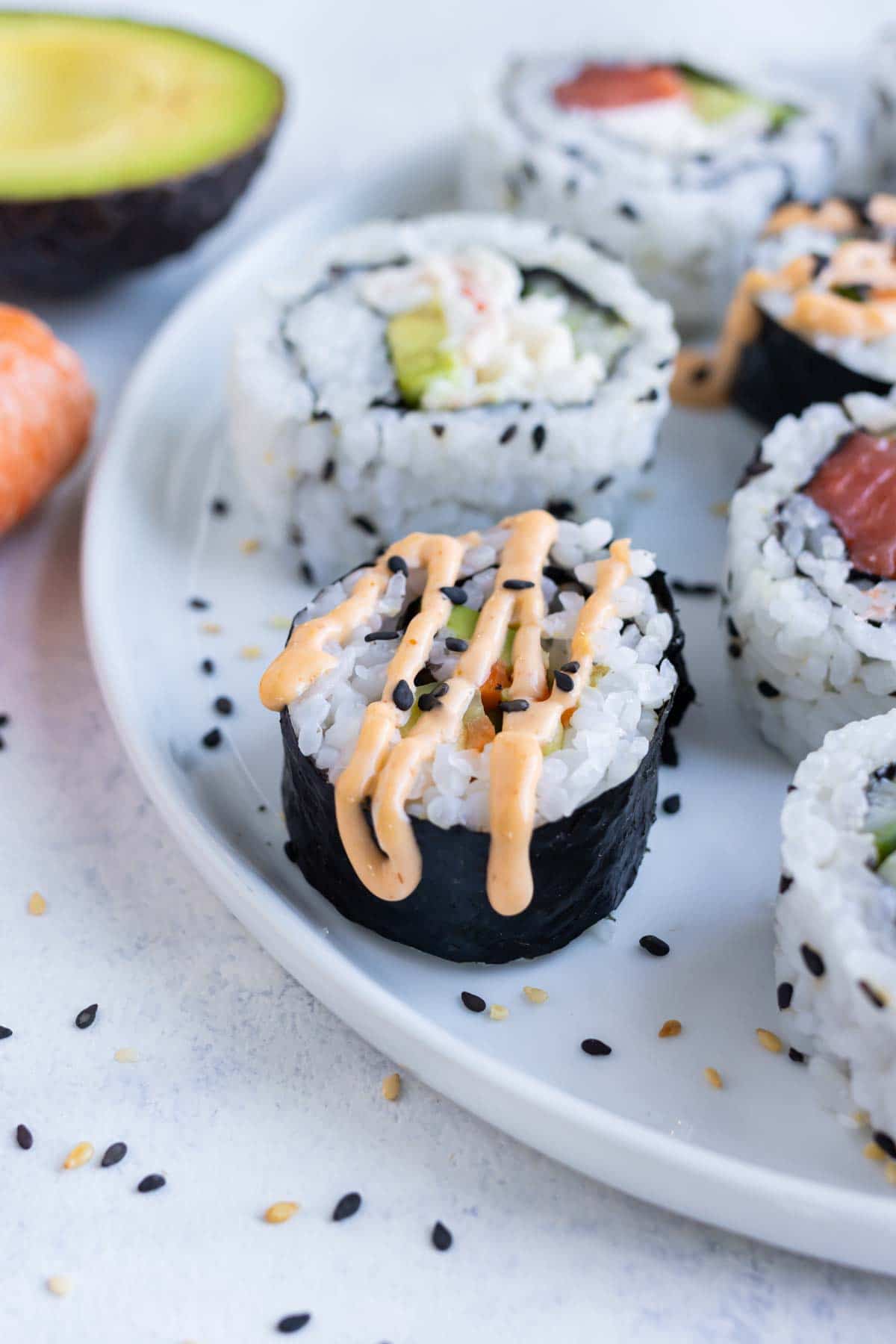
FAQs
Lightly wetting your fingers in a small bowl of water while preparing sushi can greatly help avoid sticking. This also comes in handy for sealing maki rolls and cleaning your knife, without having to step away from the roll.
If even slices are a concern but you don’t have a ruler, simply divide sections of the roll in half evenly until your desired thickness is reached. Cut the roll in halves, then quarters, then eighths, and so on.
It’s recommended to let your rice come to room temperature – not too hot, not too cold – before using it to make sushi. Rice that has gone too cold won’t stick properly, but rice that is too hot may turn mushy or rubbery within the nori.
Expert Tips and Tricks
- Find a paddle. Using a designated rice paddle is ideal, as it’s specifically designed to fluff and spread rice efficiently, unlike a spoon.
- Cover it up. Place a damp paper towel over the top of the sushi rice while you’re rolling to prevent it from drying out.
- Keep it moist. While handling the cooked rice, it can be helpful to very lightly wet your paddle and fingers to prevent sticking.
- Cut with plastic. Keep the plastic wrap on the uramaki rolls to make slicing a breeze.
- Get a little saucy. Soy sauce, wasabi, pickled ginger, citrusy ponzu sauce, and sweet eel sauce are perfect accompaniments to try with sushi.
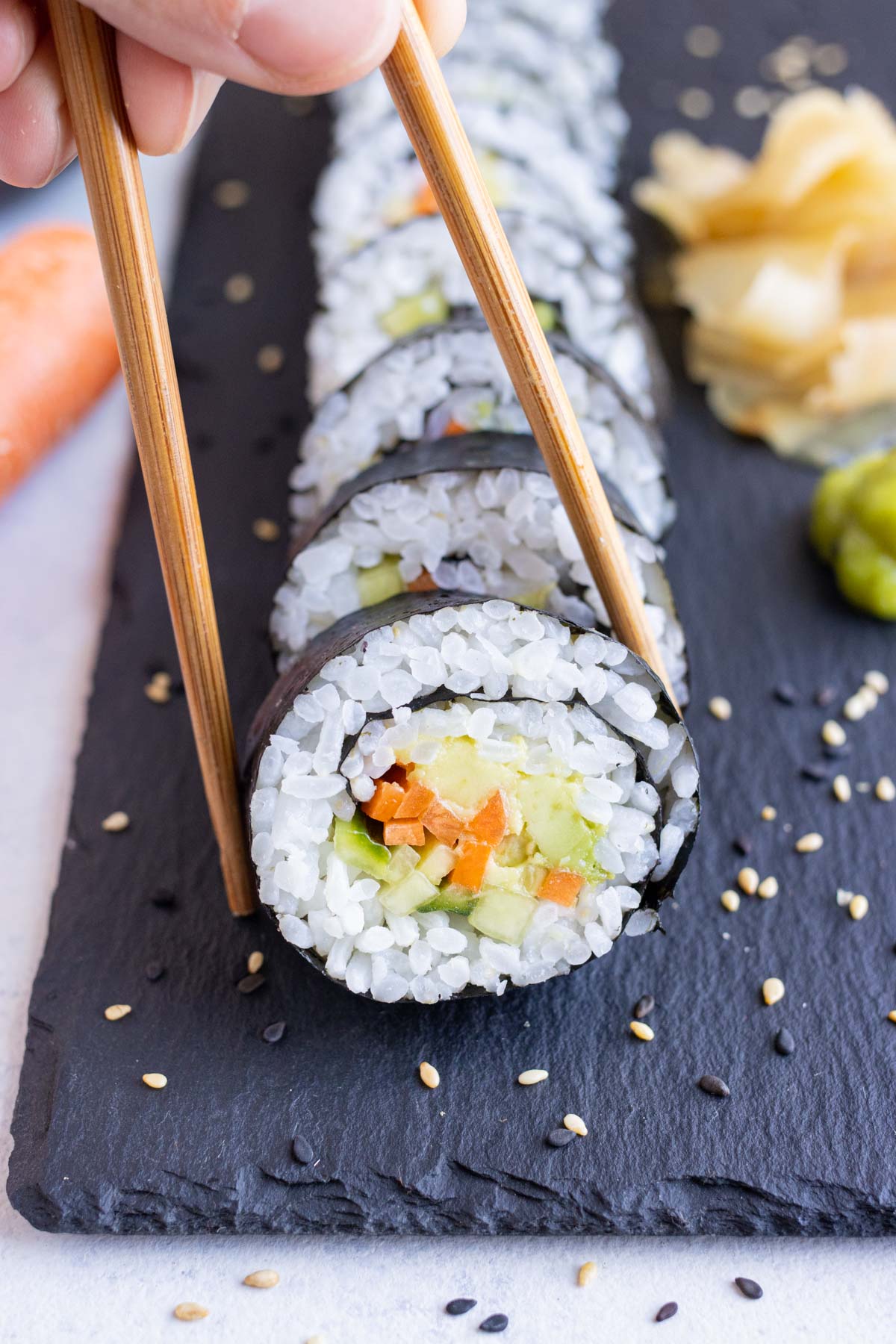
More Sushi Roll Recipes
With these two easy methods of preparation, you can use these recipes as a beginner point for making your own sushi fresh at home, too:
Tap stars to rate!
How to Roll Sushi

email this recipe!
Ingredients
- 1 cup sushi rice
- 1 piece nori roasted
- Toasted sesame seeds black
- Filling ingredients
Instructions
Maki (Traditional) Method:
- Place a sheet of nori onto a bamboo mat, rough side-up, and with the lines running in the same direction as the bamboo mat. Add 1 cup of sushi rice and spread it out as much as you can with a rice paddle. Then, get your fingertips wet with a little water and lightly spread out the rice to all of the edges except for the one furthest from you. You’ll want to stop ½-inch from that end so the nori can seal once rolled.
- Slightly off-center and close to you, place the filling ingredients in a row. Sprinkle on some salt, if desired.
- Starting from the end by you, lift up the mat over the vegetables and begin rolling, pushing back in the filling as you go. Make sure to tighten up the roll for the best results.
- Once you’ve completely rolled up the sushi, wet your fingers and run it along the ½-inch piece of nori that was left uncovered. This will make the nori stick together and seal the roll.
Uramaki (Inside-Out) Method:
- Place a sheet of nori onto a bamboo mat, rough side-up, and with the lines running in the same direction as the bamboo mat. Add 1 cup of sushi rice and spread it out as much as you can with a rice paddle. Then, get your fingertips wet with a little water and lightly spread out the rice to all of the edges. Sprinkle on some toasted black sesame seeds, if desired. Place a piece of plastic wrap over the rice and flip the nori over onto the bamboo mat.
- Slightly off-center and close to you, add the filling ingredients in a row and add a sprinkle of salt, if desired.
- Starting from the end by you, lift up the mat and begin rolling, pushing back in the filling as you go. Make sure the plastic wrap isn’t getting wrapped up in the roll.
To Cut the Sushi Roll:
- You can either cut it with the plastic wrap still on (the easiest way!) or remove the plastic and then cut. Either way you’ll want to run a sharp chef’s knife under cold water and cut 2-3 slices at a time. Repeat this until you have cut the roll into 8-10 pieces.
- If you left the plastic wrap on, remove it before serving.
Tap stars to rate!
Video
Notes
- Tea Towel Method: If you don’t have a bamboo mat, you can always use a tea towel or a dish towel. You’ll need to place a piece of plastic wrap between it and the nori before rolling.
Meal Prep and Storage
- To Prep-Ahead: Sushi is best if eaten within the first few hours of making. But it can prepared up to 24 hours ahead of time if kept tightly wrapped in plastic wrap inside the refrigerator.
- To Store: Ideally, slice sushi as it is intended to be eaten and leave leftovers uncut. Wrap rolls or pieces together in plastic wrap for up to two days. After that, the rice will go hard and the vegetables will brown.
- To Freeze: It is not recommended to freeze sushi.
Nutrition
Nutrition information is automatically calculated, so should only be used as an approximation.

